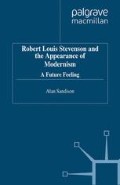Abstract
It is very tempting to begin by paraphrasing D. C. Muecke on irony and say that so many critics have already not defined Modernism that there seems to be little point in not defining it all over again. Equal circumspection about its beginnings would then be enjoined upon one as a matter of course. The trouble is that the argument against such an elegant evasion of the issue has been compellingly set out by Stevenson himself. In a devastating review of J. Clarke Murray’s The Ballads and Songs of Scotland he writes: ‘Now, modesty is a good thing in itself; but the same modesty which withholds a man from resolving a question, should certainly keep him back from publishing the fact of his indecision to the world in more than two hundred pages of type.’
Since we have explored the maze so long without result, it follows, for poor human reason, that we cannot have to explore much longer; close by must be the centre, with a champagne luncheon and a piece of ornamental water. How if there were no centre at all, but just one alley after another, and the whole world a labyrinth without end or issue?
‘Crabbed Age and Youth’
A critic is a reader who ruminates. Thus, he should have more than one stomach.
Friedrich Schlegel
…to break a butterfly on the wheel, or make it walk the plank.
Alastair Fowler
Access this chapter
Tax calculation will be finalised at checkout
Purchases are for personal use only
Preview
Unable to display preview. Download preview PDF.
Notes
Roland Barthes, Writing Degree Zero (1967), p. 9. Quoted in ‘The Name and Nature of Modernism’ in Modernism 1890–1930, ed. Malcolm Bradbury and James McFarlane (1976), p. 21.
Louis Kampf, On Modernism: The Prospects for Literature and Freedom (Cambridge, Mass., 1967), p. 9.
Michael Levenson, A Genealogy of Modernism: A Study of English Literary Doctrine 1908–1922 (Cambridge, 1986), p. xi.
William Archer, ‘Robert Louis Stevenson: His Style and his Thought’. Quoted in Paul Maixner, Robert Louis Stevenson: The Critical Heritage (1981), pp. 160, 161.
Quoted in Peter Faulkner (ed.), A Modernist Reader: Modernism in England 1910–1930 (1986), p. 23.
Peter Keating, The Haunted Study: A Social History of the Novel 1875–1914 (1989), p. 97.
Maurice, M., ‘What Modernism Was’ in Journal of Modern Literature, Vol. 3, 1974, p. 1072.
See Janet Adam Smith (ed.), Henry James and Robert Louis Stevenson: A Record of Friendship and Criticism (1948), p. 267.
Roger Swearingen (ed.), An Old Song and Edifying Letters of the Rutherford Family (Paisley, 1982), p. 15.
Kenneth Graham, ‘Stevenson and Henry James: A Crossing’, in Robert Louis Stevenson, ed. Andrew Noble (1983).
H. G. Wells, Experiment in Autobiography (1934), vol. 2, pp. 494–5.
Gertrude Stein, Picasso: The Complete Writings, ed. Edward Burns (Boston, 1970), p. 38.
Ricardo J. Quinones, Mapping Literary Modernism: Time and Development (Princeton, 1985), p. 118.
Peter Brooks, Reading for the Plot: Design and Intention in Narrative (New York, 1985), p. 317.
Clement Greenberg, ‘The Necessity of “Formalism”’ in New Literary History, vol. 3, no. 1, Autumn 1971, p. 172.
Roland Barthes, ‘Style and its Image’. Quoted in David Lodge, The Modes of Modern Writing: Metaphor, Metonymy, and the Typology of Modern Literature (1979), p. 63.
Claude Lévi-Strauss, Tristes Topiques (New York, 1961). Quoted in David Lodge, op. cit., p. 64.
M. M. Bakhtin, The Dialogic Imagination: Four Essays by M. M. Bakhtin, ed. Michael Holquist, trans. Caryl Emerson and Michael Holquist (Austin, 1981), p. 7.
Edward W. Said, Beginnings: Intention and Method (Baltimore, 1975), p. 171.
Dorothy Van Ghent, The English Novel: Form and Function (New York, 1953), p. 147.
Copyright information
© 1996 Alan Sandison
About this chapter
Cite this chapter
Sandison, A. (1996). Introduction: ‘A Future Feeling’. In: Robert Louis Stevenson and the Appearance of Modernism. Palgrave Macmillan, London. https://doi.org/10.1057/9780230376397_1
Download citation
DOI: https://doi.org/10.1057/9780230376397_1
Publisher Name: Palgrave Macmillan, London
Print ISBN: 978-1-349-39295-7
Online ISBN: 978-0-230-37639-7
eBook Packages: Palgrave Literature & Performing Arts CollectionLiterature, Cultural and Media Studies (R0)

